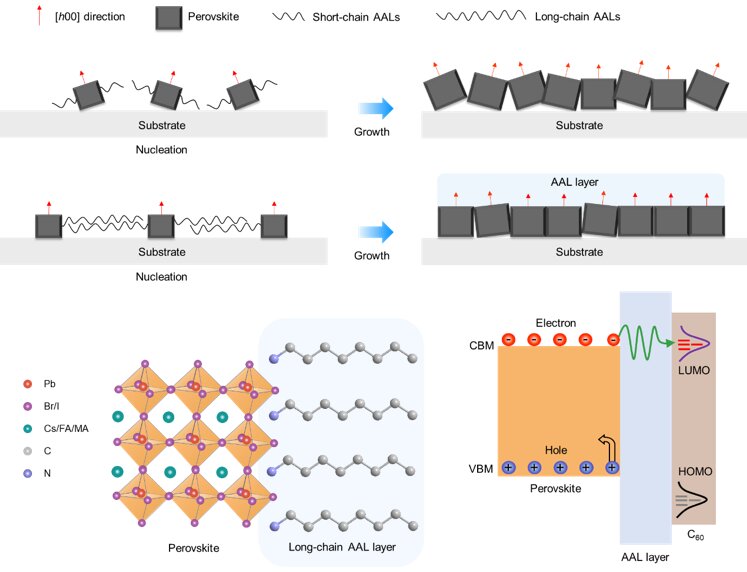February 10, 2020 feature

Photovoltaic (PV) cells, which can generate energy from the sun, could be very useful in tackling the current environmental crisis. Perovskite PV cells, cells made of metal halide perovskite semiconductors, have recently proved to be particularly promising, as researchers have managed to improve their power conversion efficiencies substantially, from 3.8% all the way to 25.2%.
Their remarkable efficiencies make perovskites a leading contender in the development of the next-generation of low-temperature-processable PV technologies. Perovskite PV cells can have two main design archetypes: the so-called regular (n-i-p) structure and the inverted (p-i-n) structure. So far, cells with a regular structure have achieved the highest power conversion efficiencies, while those with an inverted structure have achieved far longer operation times.
Researchers at King Abdullah University of Science and Technology (KAUST) and the University of Toronto were recently able to reduce the previously observed efficiency gap between perovskite PV cells with a regular structure and those with an inverted structure. Their paper, published in Nature Energy, introduces a new design strategy that allowed them to fabricate inverted solar cells with long operation lifetimes and power conversion efficiencies of 22.3%.
"Perovskite PV devices with the highest efficiencies, which are based on the regular structure, have to incorporate ionic dopants in their hole transport materials," Xiaopeng Zheng, one of the researchers involved in the study, told TechXplore. "By getting rid of these unstable dopants, inverted PV devices have contributed to the advances in the technology's operational stability. Unfortunately, the power conversion efficiencies of inverted perovskite PV lag significantly behind those of regular structured devices (20.9% vs. 25.2%)."
According to Zheng, for perovskite PV technologies to have a real commercial and environmental impact, researchers will first need to ensure that they excel both in their operational stability and power conversion efficiency. The design strategy that he developed in collaboration with his colleagues at KAUST and the University of Toronto could help to achieve this by improving the structural and optoelectronic properties of perovskite materials that are typically used to make PV devices.
Zheng and his colleagues added a trace amount of surface-anchoring alkylamine ligands (AALs) with different chain lengths to their perovskite material. This allowed them to alter some of the material's properties, leading to higher power conversion efficiencies than those typically observed in perovskite PV solar cells with an inverted structure.
"We found that only a trace amount of alkylamine during processing was enough to alter the properties of the perovskite material in the following advantageous ways: (i) promoting crystal grain orientation; (ii) suppressing trap state density; (iii) reducing charge carrier nonradiative recombination (i.e. loss), as well as enhancing carrier mobilities and diffusion lengths; (iv) inhibiting ion migration in the perovskite," Yi Hou, another researcher involved in the study, told TechXplore.
The AAL surface-modified perovskite films used by Zheng, Hou and their colleagues exhibit a (100) orientation and a substantially lower trap-state density compared to non-modified films. They also present enhanced carrier mobilities and diffusion lengths, which result in devices with a certified stabilized power conversion efficiency of 22.3%.
"Perovskite PVs are a young technology and they still have room to improve their stability to approach other well-established PV technologies, such as c-Si and inorganic-based thin films," Ted Sargent, another researcher involved in the study, told TechXplore. "We have substantially reduced the efficiency gap between inverted devices and regular devices using just trace amounts of alkylamine as grain and interface modifiers."
The researchers found that perovskite solar cells created using their approach can operate for over 1,000h at the maximum power point under a simulated AM1.5 illumination, without any loss of efficiency. In the future, the design strategy they introduced could bring perovskite materials closer to fulfilling the demanding conditions required for the commercialization of solar cells.
"For the next stage of our research, we will look into ways of producing perovskite PVs, to achieve large area devices without compromising on high performance and reliability," Osman Bakr, another one of the researchers involved in the study, told TechXplore.
More information: Xiaopeng Zheng et al. Managing grains and interfaces via ligand anchoring enables 22.3%-efficiency inverted perovskite solar cells, Nature Energy (2020). DOI: 10.1038/s41560-019-0538-4
© 2020 Science X Network
Citation: Inverted perovskite solar cells with a power conversion efficiency of 22.3% (2020, February 10) retrieved 10 February 2020 from https://techxplore.com/news/2020-02-inverted-perovskite-solar-cells-power.html
This document is subject to copyright. Apart from any fair dealing for the purpose of private study or research, no part may be reproduced without the written permission. The content is provided for information purposes only.
